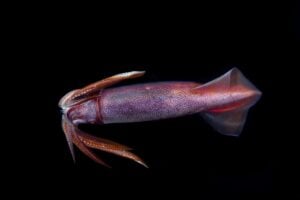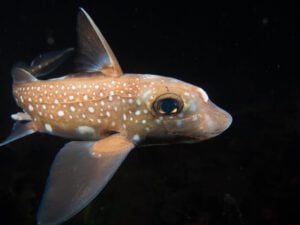Basking sharks are one of the most fascinating yet elusive creatures off British Columbia’s coast. Once a common sight along BC’s coast, these enormous filter feeders have become rare, their numbers drastically reduced due to human activities. This article explores the unique characteristics of basking sharks, their role in marine ecosystems, their cultural significance, and efforts to protect and restore BC populations.

Why Are They Called “Basking Sharks?”
Basking sharks (Cetorhinus maximus) are the second-largest fish in the world, second only to the whale shark. They can grow up to 12 meters (40 feet) in length and weigh as much as 5 tonnes. Despite their enormous size, basking sharks pose no threat to humans. Basking sharks are filter feeders, subsisting on plankton, tiny fish, and other microscopic organisms that they filter from the water with their massive, gill-raker-lined mouths.
The name “basking shark” comes from their behaviour of slowly swimming near the surface of the water, appearing to bask in the sun. As they move forward, seawater continuously flows into the sharks’ open mouths and through their gills.
Basking sharks do not use their many rows of about 1,500 hook-shaped teeth during feeding. Instead, scientists believe that males chase and bite females during mating. Mating sharks will gather in groups of up to 50 individuals, with males circling and closely following females for several hours. During social interactions, basking sharks will also launch their entire bodies out of the water, a behaviour known as breaching. Scientists think that large male sharks breach to compete for the attention of a female, while mature female sharks may breach to signal receptiveness to mating.
The Cultural Significance and History of Basking Sharks in BC
Historical records from the 19th century indicate that the Nuu-chah-nulth and Huu-ay-aht peoples hunted basking sharks off Vancouver Island. Unlike more elusive marine animals like seals, basking sharks are relatively easy to approach due to their slow-moving nature, making them prime targets for harpooning. When basking sharks were plentiful along the Canadian west coast, they were primarily hunted for their liver oil, which was valuable for its uses in lighting, waterproofing, and as a lubricant. In Clayoquot Sound, a stream named “Shark Creek” reflects this history, named after the Nuu-chah-nulth word for basking shark, mamach-aqtlnit.

The basking shark fishery was a lucrative industry in the northeast Atlantic around Scotland, Ireland, and Norway. There, basking sharks were also targeted for their oil-rich livers and were heavily fished from the 18th to 20th centuries. While basking sharks were not hunted commercially in BC, by the 1950s, fishing fleets in BC considered them to be a nuisance as basking sharks would unwittingly get caught in fishing nets. Complaints from fishers prompted the Department of Fisheries and Oceans to conduct an eradication program.
The eradication measures included a “Basking Shark Control Program,” launched in 1955, which encouraged fishermen to report and kill any basking sharks they encountered. The DFO even equipped boats with sharp blades known as “shark knives” mounted on the bows, specifically designed to cut through basking sharks that were sighted near fishing nets. These methods proved highly effective in reducing the population of basking sharks, which were already vulnerable due to their slow reproductive rate.

By the early 1970s, the basking shark population had been severely diminished, leading to their functional extinction in Canadian Pacific waters. The DFO’s eradication program is now viewed as a significant factor contributing to the decline of basking sharks in the region. Since then, the species has been listed as endangered under the Canadian Species at Risk Act (SARA), and efforts are now focused on conservation and recovery, although sightings remain extremely rare.
The Role of Basking Sharks in Biodiversity and the Ecosystem
Basking sharks play a crucial role in marine ecosystems as large filter feeders. By consuming vast amounts of plankton, they help regulate plankton populations, which are the foundation of the ocean food web. An overabundance of plankton can lead to imbalances affecting the availability of oxygen and nutrients in the water. Some plankton species, if left unchecked, can contribute to algal blooms, which can produce toxins harmful to marine life, human health, and local economies.

Additionally, basking sharks contribute to nutrient cycling. As they move through different layers of the ocean, they help distribute nutrients, which supports productivity in our oceans. Their decline can be an indicator of ecosystem health, as their numbers often reflect changes in plankton abundance and water quality.
Basking Sharks in BC Today: Are They Being Protected?
Basking sharks are now protected in BC, making it illegal to harm, capture, or disturb them in Canadian waters. Despite these protections, sightings of basking sharks in BC are still extremely rare, and their numbers remain critically low. The recovery of basking sharks is hindered by their slow reproductive rate; females take several years to reach maturity and produce only a small number of offspring.
Although harvesting this species is prohibited in many countries today, there remains an active illegal market for basking shark products. Basking sharks remain vulnerable to entanglements in fishing gear, ship strikes, disturbance from tour boats, and habitat destruction from coastal developments, because they feed and socialize near the shore.
In June, on Wallace Island in the Gulf Islands, a woman spotted a basking shark. Scott Wallace, co-owner of Outer Shores Lodge and an author of a book about basking sharks, told Global News that for him, a basking shark sighting is like seeing a Sasquatch or unicorn.
Conservation efforts in BC focus on habitat protection, research, and monitoring. Organizations and researchers are working to collect data on the few remaining basking sharks through sightings, satellite tagging, and public reporting initiatives. Efforts are also being made to raise awareness about the importance of basking sharks and to reduce human impacts such as bycatch and vessel strikes.
How Will Marine Protected Areas (MPAs) Help Basking Sharks in BC?
The story of basking sharks in BC is a powerful reminder of the impact people can have on species—and the importance of conservation. While their numbers remain low, ongoing protection and awareness efforts offer hope for the future. By valuing these gentle giants not just as part of our marine biodiversity but as integral components of healthy oceans, we can work towards restoring their presence in BC’s waters.

Marine Protected Areas (MPAs) can significantly benefit basking sharks in BC by providing a safe and regulated environment that supports the recovery and conservation of their population. Here are some ways in which MPAs can help basking sharks:
- Habitat Protection: MPAs safeguard critical habitats that are essential for basking sharks, including feeding grounds, migration routes, and potential breeding areas. By protecting these areas from fishing, industrial development, and pollution, MPAs ensure that basking sharks have access to safe and undisturbed environments that are vital for their survival.
- Reduction of Human Disturbance: Within MPAs, human activities that pose threats to basking sharks, such as boat traffic, noise pollution, and direct harassment, are regulated or restricted. This lowers the risk of injury or death from vessel strikes, entanglement in fishing gear, and other human-caused threats. Fishing restrictions within MPAs reduce the likelihood of basking sharks being accidentally caught or entangled in fishing nets. This is particularly important because bycatch is a significant threat to basking shark populations. MPAs that limit or ban certain types of fishing gear can effectively minimize this risk.
- Scientific Research and Monitoring: MPAs provide a controlled environment where scientists can research and monitor basking shark behaviour, migration patterns, and population dynamics. A better understanding of these animals is essential for conservation strategies and assessing the effectiveness of protection measures.
By providing a safe haven with reduced human impact, MPAs can play a crucial role in the recovery and long-term conservation of basking sharks in BC, helping to restore this endangered species to healthier population levels.




